Color-drenched walls and desert beauty in Steve Martino-designed Palo Christi Garden
Forget Easter egg pinks and lilacs. Yellow, I discovered two weeks ago, is the color of spring in Arizona. A sunny, egg-yolk yellow.
My friend David Cristiani introduced me to Phoenix landscape architect Steve Martino, who pioneered the use of desert natives in area gardens decades ago. Steve generously took time out of a busy spring schedule to show me two of his clients’ gardens in Paradise Valley. This is the scene that greeted me at the Palo Christi Garden. Like forsythia on steroids, green-trunked palo verde trees (Parkinsonia sp.) glowed golden against an azure sky.
Near the driveway, a laser-cut metal pillar with an uplight is a beacon on velvety desert nights. Pincushions of golden barrel cactus pick up the yellow of the blooming palo verdes and brittlebush.
A low, chrome-yellow wall is, like the light pillar, another marker for the garden. In the desert, bloom color is fleeting, and rich color on walls brings energy to the normally subdued palette of grey-greens and blue-greens. Also, such colors stand up to the intense desert sunlight, which washes out paler hues.
Steve told me that walls also allow him to design for shadow play. It’s smart to put that powerful desert sunlight to use.
Throughout the garden, an assortment of architectural and Dr. Seussian plants bring this garden to life while requiring very little water, like agave and purple prickly pear…
…Agave americana ‘Variegata’…
…and green-limbed palo verde. The eye-catching green branches are able to photosynthesize when the tree drops its leaves to conserve water during times of drought.
Approaching via a driveway that winds through one side of the garden, visitors have time to shrug off the outside world before they even step out of the car.
A red wall paired with silver-blue agaves offers a dramatic welcome in the gravel parking court.
Inside a walled courtyard, a modern oasis beckons. The straight lines of a trough-like raised pool lead the eye from the house to a vista of rugged mountains.
Linking the house to the pool…
…a substantial arbor provides shade, which is essential to desert gardens.
Naturalistic but densely planted, the garden is as horticulturally varied as a wash, or wet-weather creek. In the desert, Steve explained, the wash is where the action is, where you find the greatest diversity of plants.
Variegated agaves writhe like octopi, adding strong form and a feeling of movement.
Yucca rostrata introduces more shadow play against the sand-colored wall of the contemporary-style house.
Neutral-colored garden walls make a strong yet simple backdrop for furnishings and accessories.
From inside the home you see another courtyard, with a second water feature that’s aligned on an axis with the trough in the entry courtyard, both of which are visible through the home’s floor-to-ceiling windows. From indoors, the narrow bands of water appear to run in a direct line through the house. This illusion makes the surrounding garden central to the experience of being in the home.
This courtyard is more open than the other, and more sparsely planted. The trough bisects the space, shaded by a flowering palo verde on one side and guarded by soldier-straight Mexican fence post cactus on the other.
Vertical white lines on the fence post cactus bring to mind pinstriping on a smart suit.
Where the trough meets the garden wall, a gap reveals a recessed cobalt wall, from which a simple pipe spills a steady stream of water. Nowhere is the sound of water more welcome than the desert.
Blue wall, yellow blossoms
Steve was working the scene too, taking as many photos as I did. He is serious about his photography.
On the other side of the courtyard, cactus and succulents cluster near the windows, leaving the center open for entertaining on cool desert nights.
The gravel floor blends with the sand-colored walls of the house, making the space feel even larger.
Nearly hidden, a narrow gate opens onto a walled, raised-bed vegetable garden.
Nearby, ocotillo shadows dance on a yellow wall.
My thanks to Steve and the homeowners for letting me photograph this stunning garden. Stay tuned for another Martino-designed garden that I toured.
But first, for comparison, I thought you might like to see the garden across the street from the one we just toured. It’s an example of traditional landscaping in Phoenix, landscaping on life support, representative of the aesthetic that Steve has been working for decades to supplant: a large, thirsty lawn, palms, cypresses, bougainvillea — a Mediterranean fantasy that turns its back on the natural beauty of the Sonoran Desert. Scroll back up to see Steve’s choices of native trees, shrubs, and perennials — plants that blend with the larger landscape while still providing the lushness of a garden oasis, not to mention a significantly smaller water bill. Which would you prefer if you lived here?
All material © 2006-2014 by Pam Penick for Digging. Unauthorized reproduction prohibited.


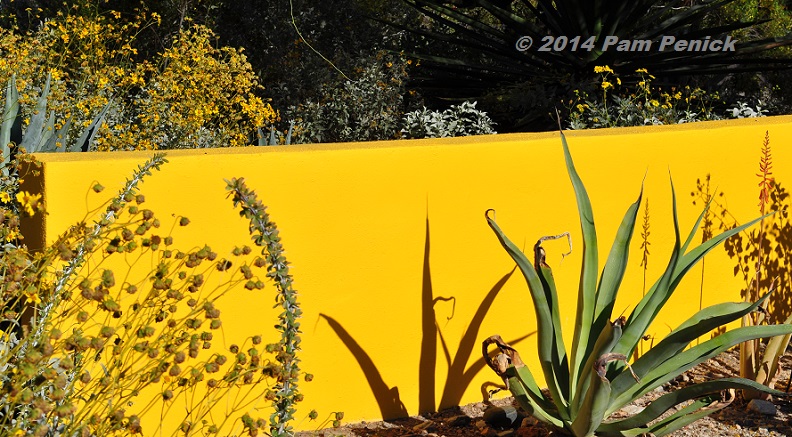
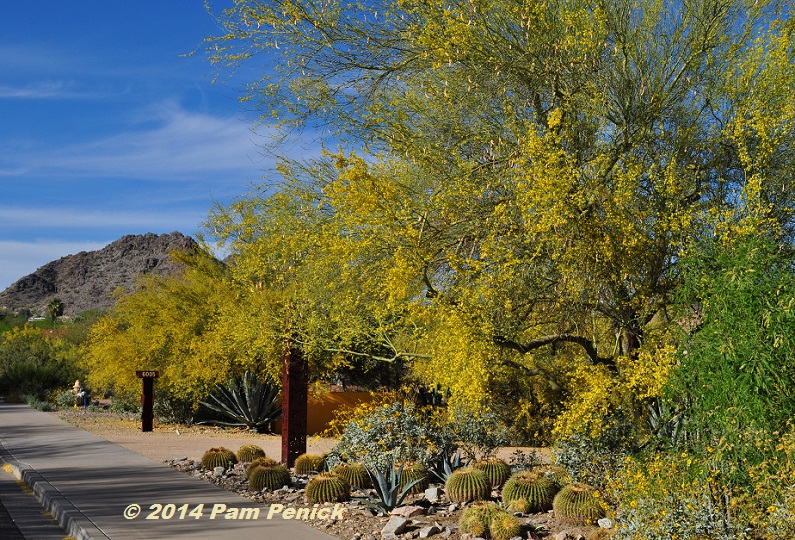
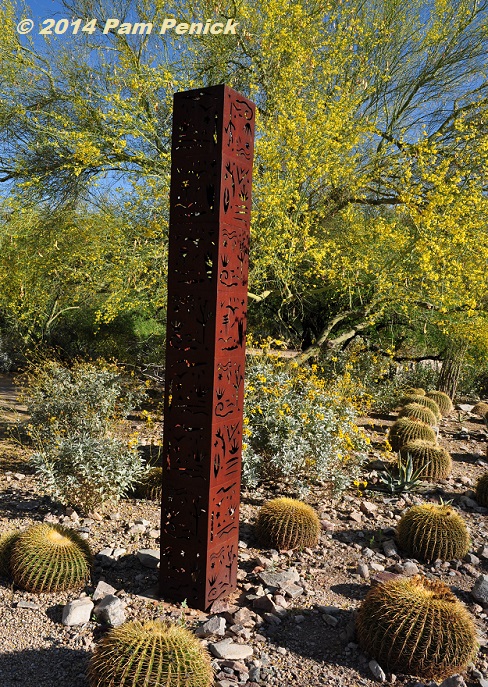
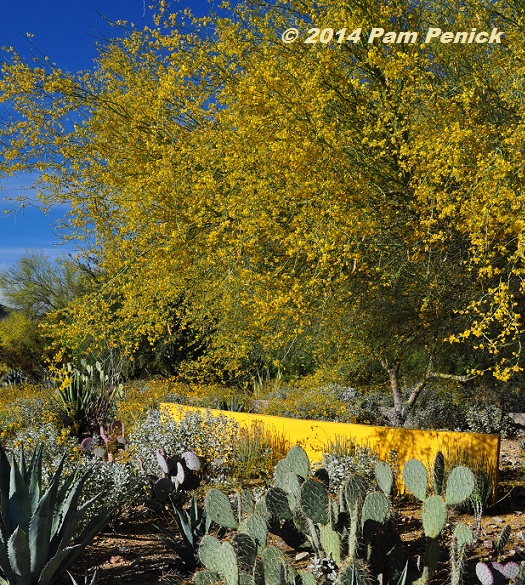
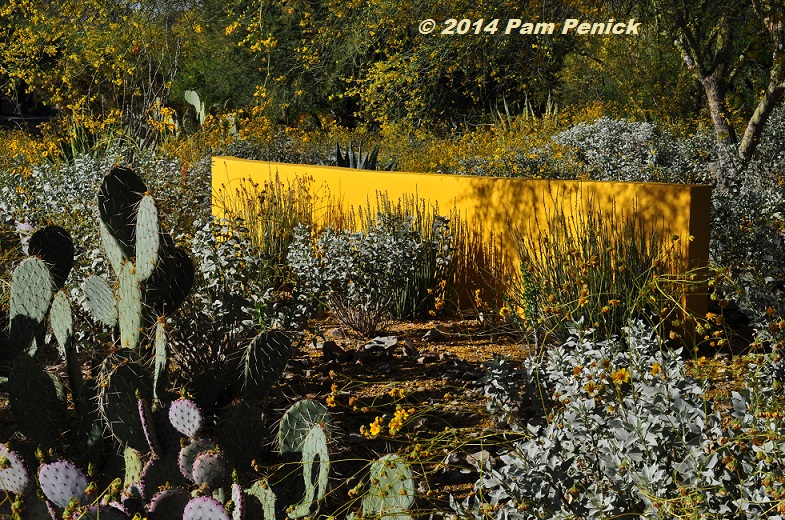
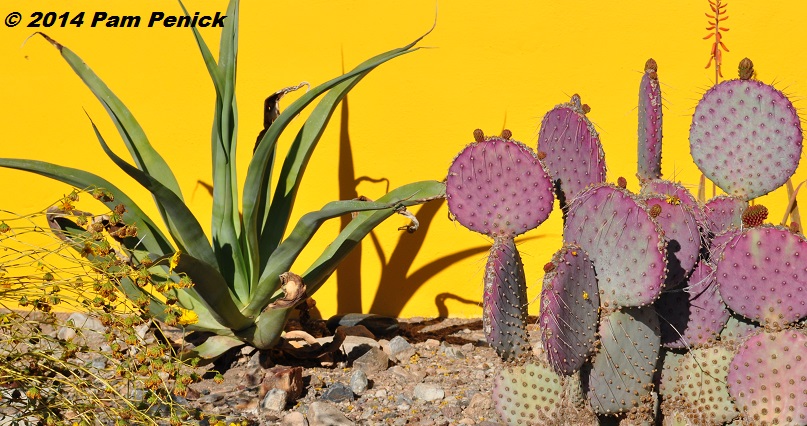
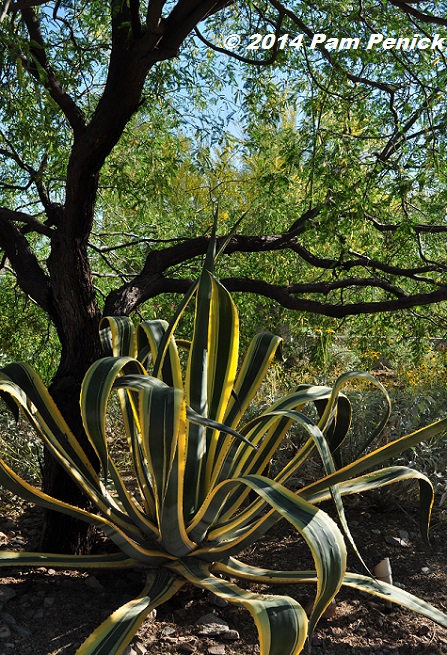
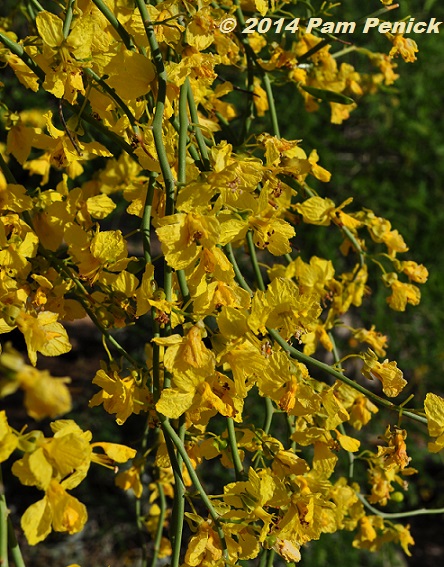
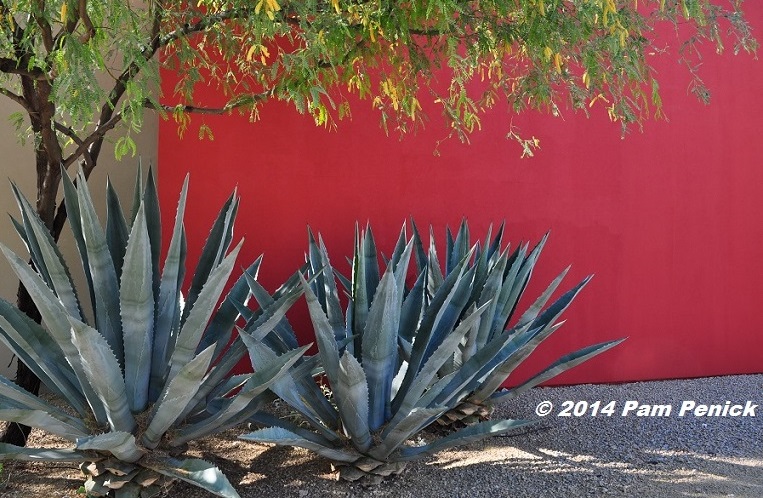
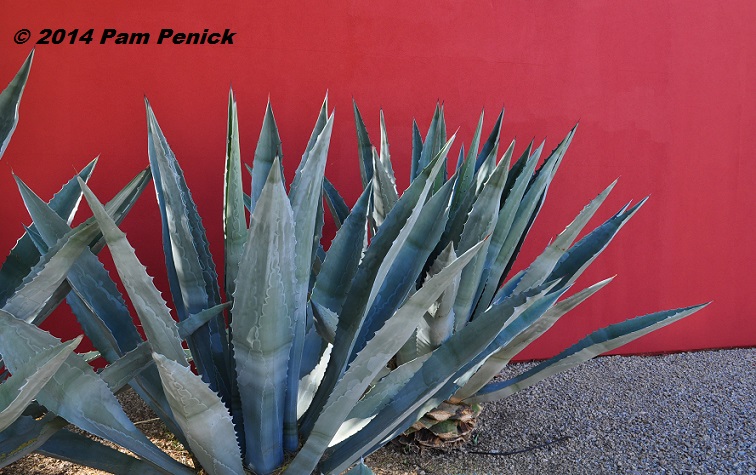
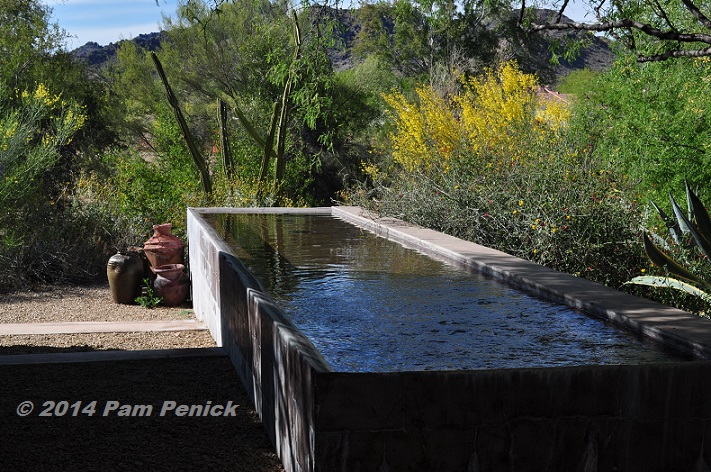
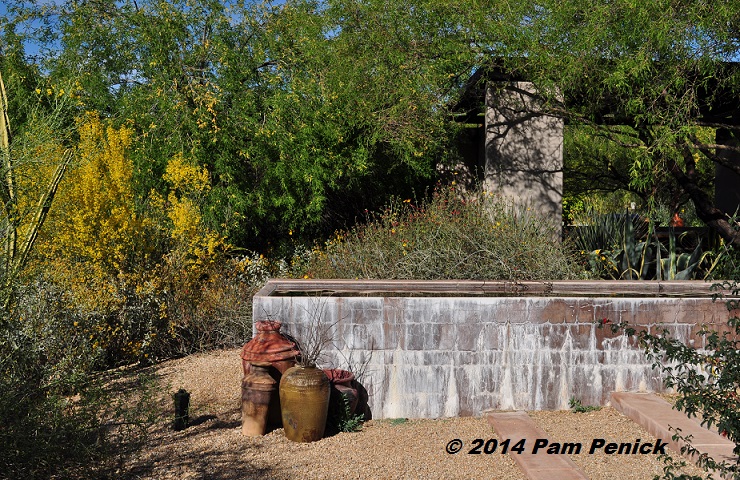
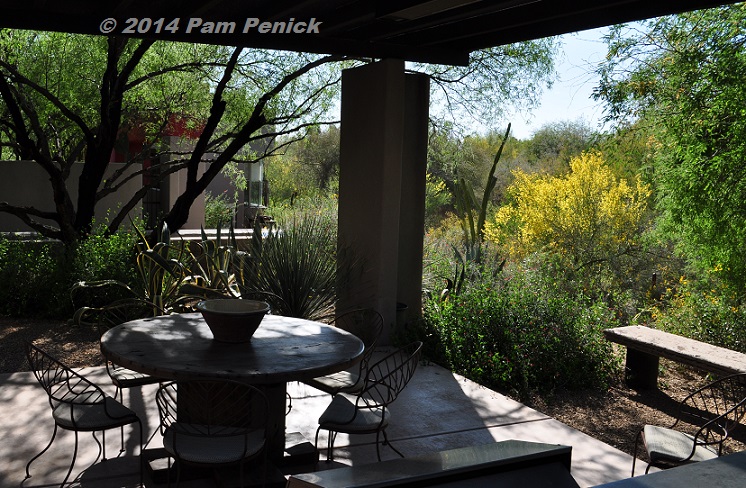
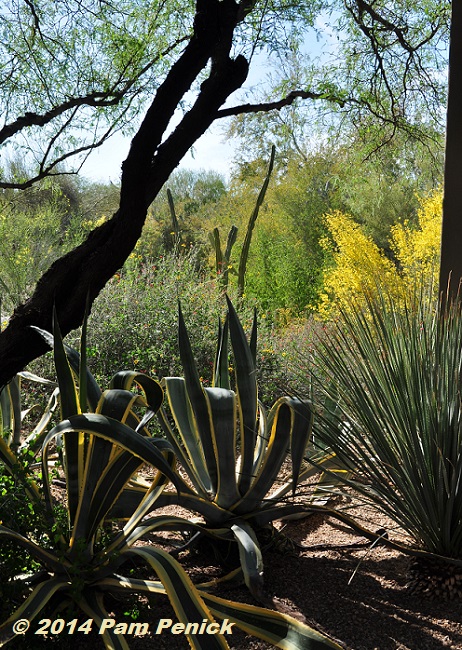
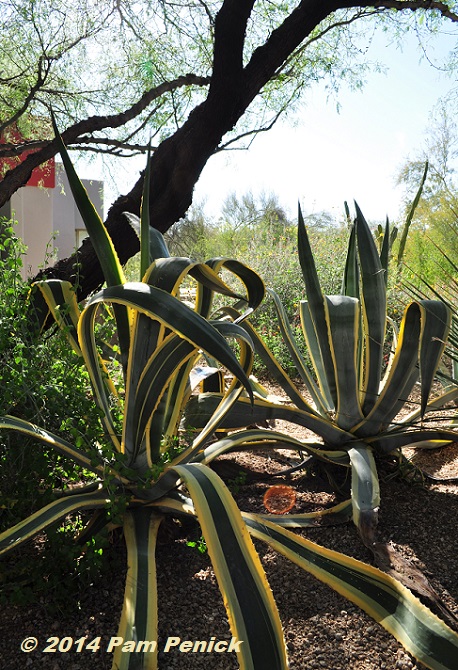
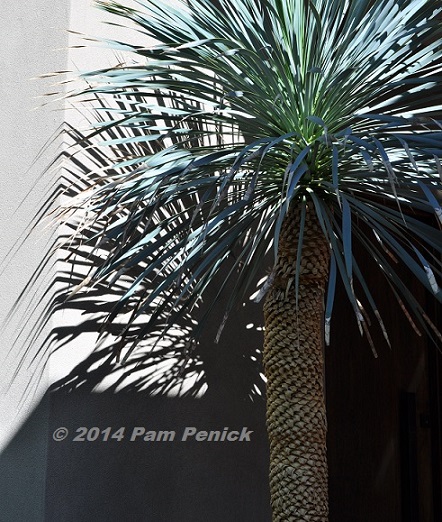
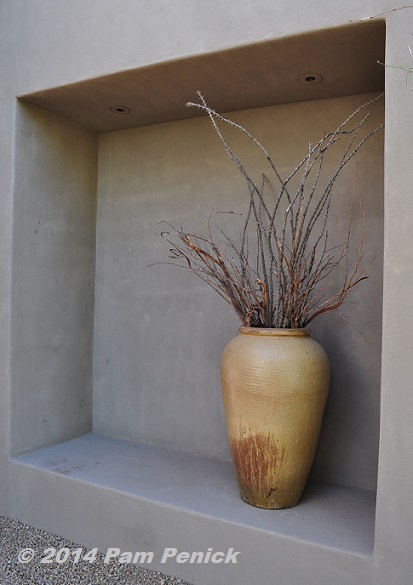
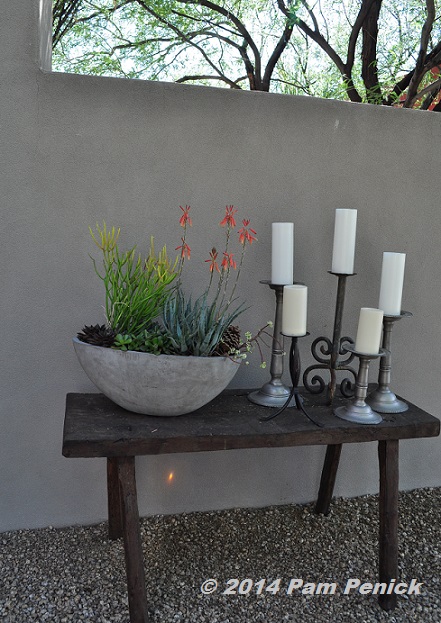
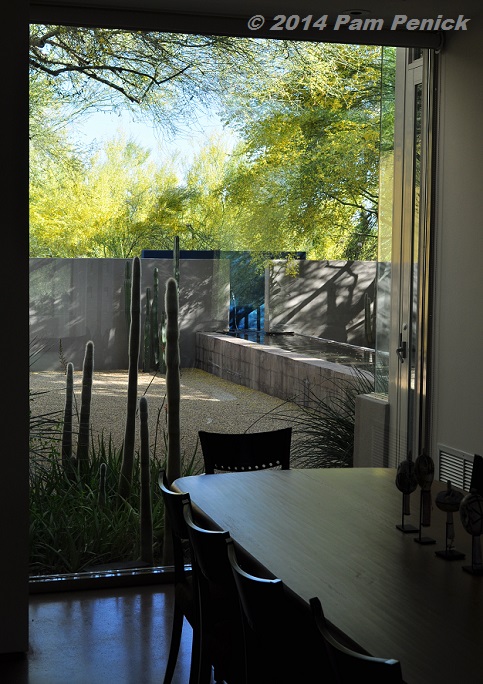
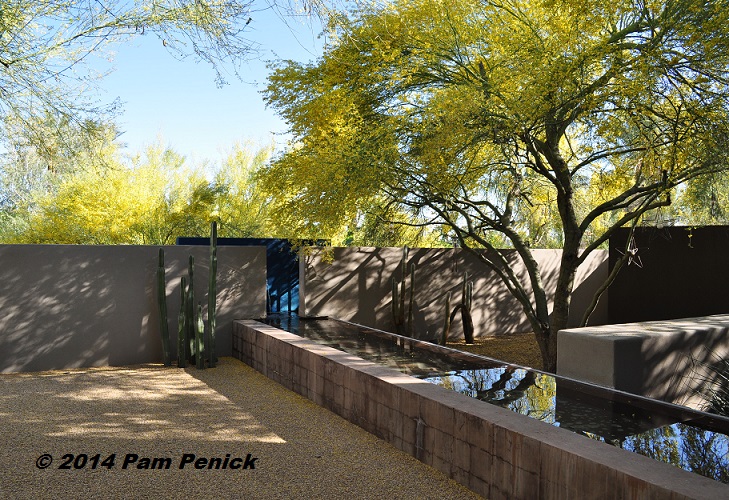

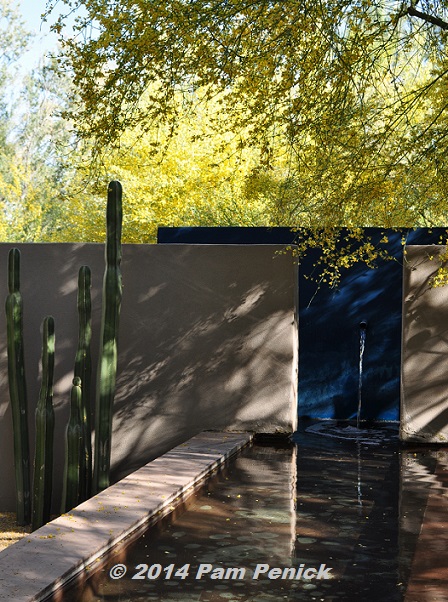
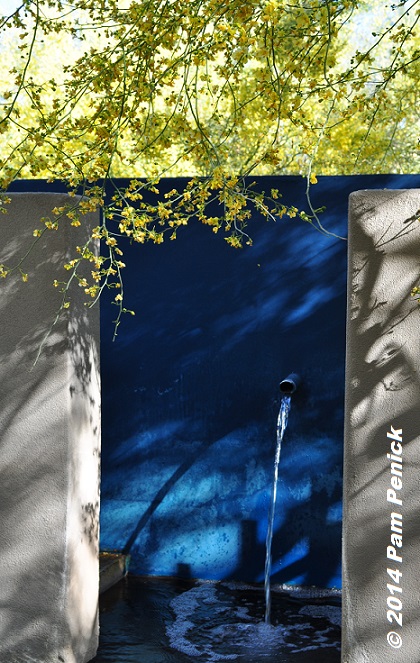
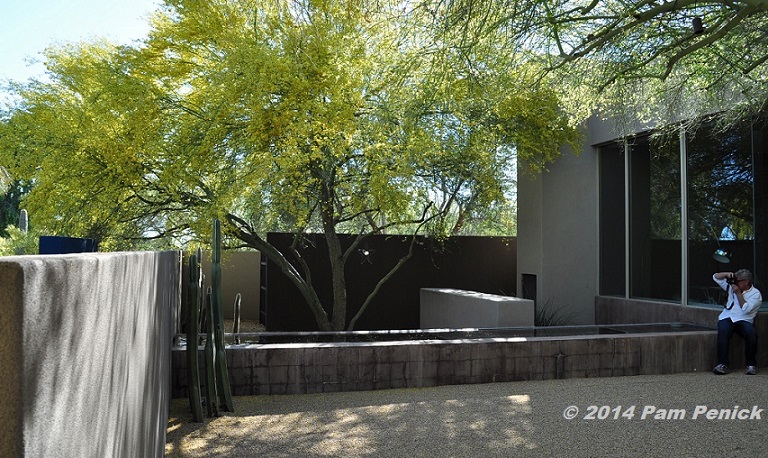
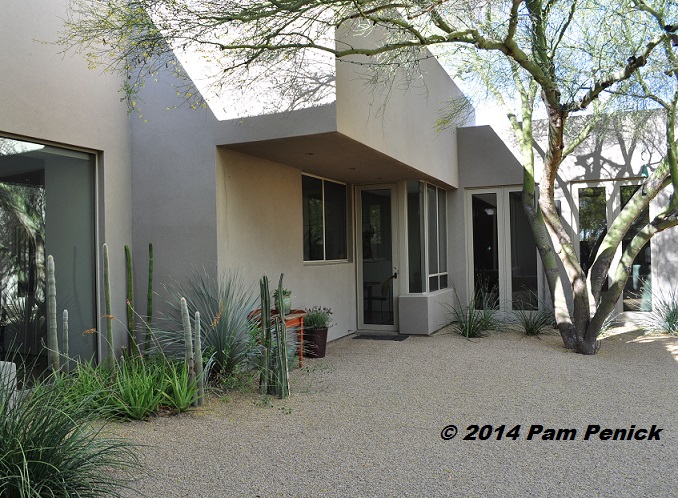
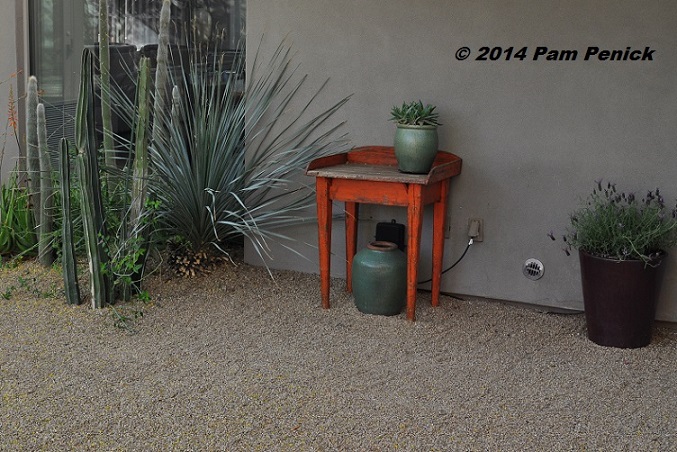
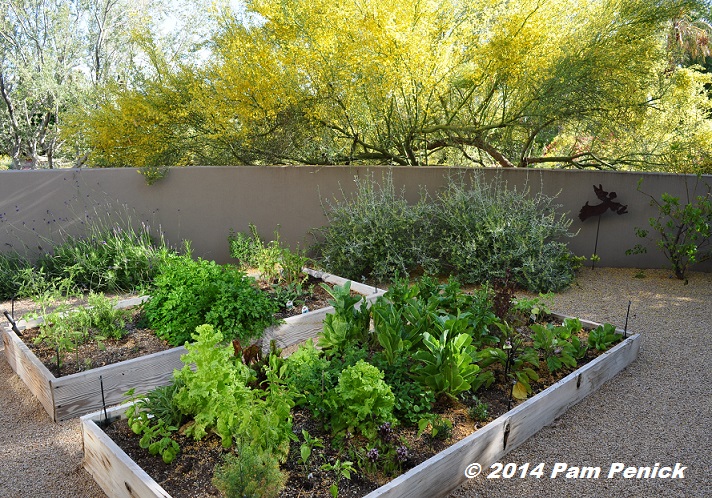
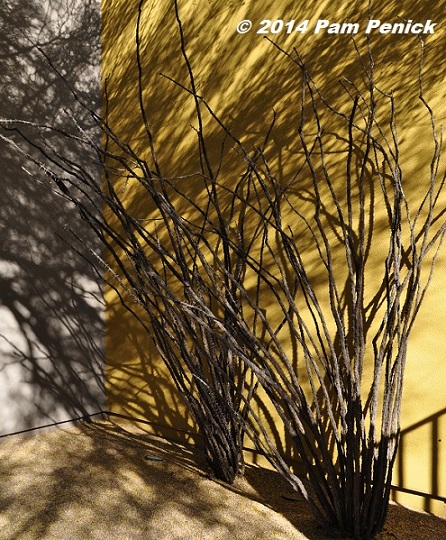
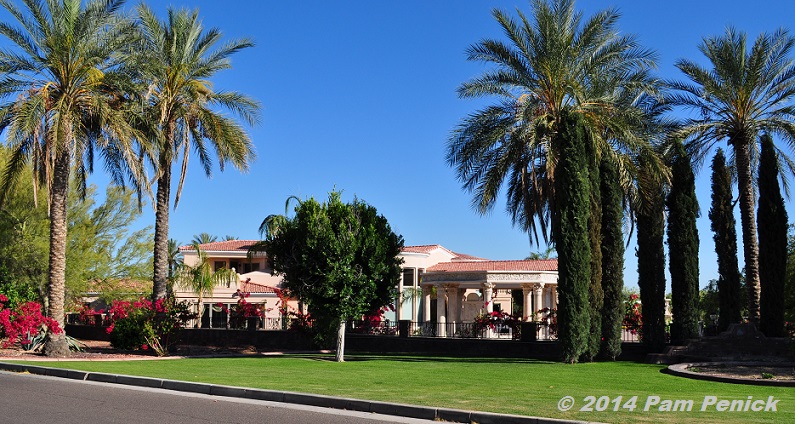
Gorgeous!
Love the colored walls and the shadows that are cast on ALL the walls. Very nice. Do they swim in the trough?
Cheryl, Steve saw your question and let me know that the water is clean and the grandkids can play in it. —Pam
Colorful, lushly planted native oasis vs. the typical desert denial. Do you even need to ask? I especially enjoyed seeing how the garden related to the interiors of the house. Enjoyed the tour and can’t wait to see the next one.
The openness of the house design allows a marvelous interplay between home and garden. I wonder how closely the architect and landscape architect collaborated. —Pam
Glad to make the intro! Thanks for the tour and maybe the best pics of any of his many landscapes that I’ve seen. You nailed that lighting, discrete use of water, and the purposes of garden walls of varying heights, too. This is beyond inspiring.
Colored walls – maybe it’s your archtiectural styles there, plus less familiarity with them? My impression of all the times I’ve been to Austin, with what I consider to be gloomier skies much more than the desert and your different greenery, colored walls would really look stunning.
Thanks again for the introduction, David. Steve’s gardens are an inspiration for how to live and garden in a hot, dry climate. And I agree about the colored walls for Austin. We need some! —Pam
Beautiful. I love Palo Verde trees. And, they do look wonderful, against that desert sky.
This garden has a lush look, without being water-guzzling…as in the place across the street.
Thanks for the tour.
Looking forward to the next.
I hope to have it up tomorrow or Monday, Linda. —Pam
Oh me oh my. Simply stunning. I have been a gradual convert to the idea of gravel filled enclosures and the ones shown here surely set the standard for how this approach can be used in a way that rather than subtracting, truly adds to the impact of an outdoor space.
And those walls! I agree – the use of color ought to be a natural for Austin. I’m looking at our spaces and wondering where we could try it out!
Gravel terraces have such a natural look, with that pleasing crunch, and with the bonus of allowing rainwater to percolate through. I like them too. —Pam
The Palo Christi garden is definitely more appealing. Thanks for another fine tour, Pam!
My pleasure, Kris. —Pam
I love the use of color on the walls. It changes the way you see the plant, highlighting it’s shape and muting it’s colors! The water feature is fabulous! Thank you for the photo tour!!!
I’m glad you enjoyed the virtual visit, Laurin. —Pam
Well you know which garden I think is the best! Thanks for this fabulous tour of a garden designed by a man whose work I’ve always loved.
Yes, I was quite sure you’d be in the agave and clean-lined design camp, Loree. —Pam
Wow, you lighten my heart with these images, thank you thank you, Pam – such gorgeousness.
It truly was, Tamara. I’m glad you enjoyed the visit. —Pam
Ahh, so refreshing. I moved here from Phx nearly 8 years ago and grew up with that thirsty, forced estate (especially with the pink-taupe-mauve-beige buildings) look being the desired landscaping. There is very little room to play with non-native landscaping in the desert, let me tell ya! I would have given anything when I lived there to see more of what Steve has done here, especially those colored walls! What a sight for sore eyes. Steve proves that it’s not hard to add a little color to the desert.
When many settlers came to Phoenix and Tucson, they planted olive trees for shade. The olive trees, however, were highly allergenic, which is ironic considering one of the main reasons Phoenix was settled was due to being a low allergen area for folks with Tuberculosis and other respiratory issues. Additionally, the olive trees prolifically dropped fruit, leaving squishy, staining olives on the sidewalk. The olives had pits, so we always had to rollerskate on the road instead of the sidewalk. ANYWAY, eventually the cities placed restrictions on these trees and folks started planting a large amount of the beautiful and native palo verdes instead. 🙂
Your story about the olive trees underlines the importance of being wary about exotic plants. What a mess! Is the city working to eradicate the use of olives as street trees? —Pam
Tuscon removed them 20 years ago or so, I can’t remember about Phoenix. People also have the trees annually sprayed by arborists with growth regulators to prevent fruiting.
I could certainly live with the desert landscape but I’m not sure I could live with the summer heat. I have been in there in July and August and you can only be outside for a couple of hours in the very early morning. Of course the landscape is less maintenance so I guess I could play more bridge.
Well, that’s how I feel here in the summer, Jenny, although getting into a swimming pool makes it bearable. I think the wonderful tradeoff for a desert dweller is being able to enjoy bug-free and humidity-free evenings outdoors in the summer. —Pam
Even though the colors were warm to “hot” they nevertheless were subtle in their application. I can see why some of the great Mexican architects use such bold colors. Really appreciate this garden.
Steve mentioned some of the Mexican designers he admires. I’d like to see their work in person one day. —Pam
Given all the money in the world, would still prefer the natural beauty of Steve’s design. Having grown up in the Mojave, I could clearly imagine the cool of the cement floors on my feet while looking at the images of the shaded porch. Absolutely loved you showing the stark contrast between the 2 gardens.
The contrast is pretty stark, isn’t it? Steve told me that in his youth he worked for a landscaper, and one day, while putting in palms and olives he looked at the vacant lot next door and saw beautiful native trees in bloom with no human intervention. He asked the landscaper, “How come we’re not using those plants?” The landscaper took a glance and said, “Those are just weeds.” Steve built his business on learning about, sourcing, and designing with those “weeds,” and he calls his blog Weeds and Walls. —Pam
Yes, Luis Barragan-inspired walls and the native desert plants/”weeds” are much preferable to the lawn-based fantasy. Wonderful tour, Pam.
I’m glad you enjoyed it, Denise, and hope one of Steve’s gardens pops up on tour within driving range for you soon. —Pam
You forget one thing about the “native desert landscapes” vs the “resort” type landscapes. Everything here hurts, really badly. Nothing is friendly, no way to get into your yard, or have kids without the “resort” type of plants and effort required (and money) to grow them.
If you live inside and just look at your garden, then by all means, go native and close approximation too that. Yet if you want to actually venture into your yard with your children. Good luck with that.
I have lived here now for 12 years, kids and the desert landscaping plants, including the tree’s and agava that everyone finds so “charming” hurt, very badly.
Actually, Joe, I know quite a lot about spiky and spiny native vegetation, as I garden with these kinds of plants myself in central Texas (and have since my kids were little). I hear what you’re saying, but I respectfully disagree that this garden is, as you put it, unfriendly, offers no way “to get into your yard,” and is not enticing to kids. Many people find spiny plants to be beautiful and enticing, not off-putting, in the way they catch the light, add natural architecture to the garden, and provide a sense of place. In a well-designed garden like this one, they are positioned carefully around patio spaces so that you don’t run into them accidentally, and the patios flow outdoors directly from the indoor living spaces, practically offering an engraved invitation to come outdoors.
As for designing for kids, although these owners don’t have small children and didn’t need a lawn, Steve Martino’s gardens sometimes do include a play lawn (see this Martino garden). However, while a lawn might be desirable for kids, it isn’t a necessity. Most lawns go unused (except by the lawn mower) and can be scaled down to “just enough” or eliminated altogether. Sterile lawns bore kids — unless they’re into ball games, and these are usually played on municipal fields these days — and they’d rather climb on rocks and jump off of them, explore a desert wash or grassy meadow, hunt for bugs, or play in a kid-safe water feature.
Obviously not everyone is going to love desert gardens (although how sad to live in a place and never develop an appreciation for its natural beauty), but using copious amounts of water in a desert to have a big, green lawn and exotic palms is wasteful. What Steve’s gardens show, and what I advocate, is that gardening with native and adapted plants is not only ecologically smart but beautiful and enticing. The Sonoran Desert is never going to look like Connecticut, or the South of France for that matter — and why would anyone want it to? —Pam
As my friend said when he lived in Tempe, “You only have to tell your child not to touch the teddy bear cholla once.”
Despite its cuddly name, that plant really does have a bite, doesn’t it? But that’s just another example of a plant that provides nesting places for birds and catches the morning and evening light so beautifully, and so long as you site it away from paths, patios, and play spaces, you can enjoy it in safety. It doesn’t have to be all or nothing with desert plants either. Save the lawn for a small space near the back door, and design a low-water desert garden for a broad perimeter. —Pam